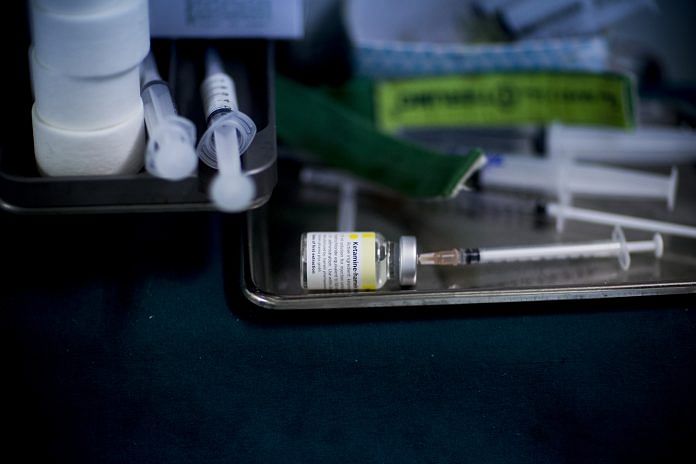Bengaluru: Past studies have shown that ketamine is a rapid antidepressant, working within mere hours to produce a substantial alteration in a patient’s mind state, as opposed to traditional antidepressants which can take several weeks to show results.
Now, to understand the molecular mechanism of how the drug works so quickly, a team of researchers from Chicago, USA, observed neuronal activity in the brains of mice when exposed to ketamine.
The findings of the study, which have been peer-reviewed, were published in the scientific journal Nature Communications last month.
Ketamine is an anesthetic, primarily used to induce strong pain relief and sedation. It is commonly used as surgical anesthesia for animals. It has also been used recreationally since its creation in various forms, and can lead to dependence when used frequently.
A single dose of ketamine can decrease depressive symptoms within hours and its effects on the brain can persist for up to three weeks. Previous studies show that even those patients who are resistant to antidepressants, respond to even a single dose of ketamine.
Traditional antidepressants work by neurogenesis, or creation of new neurons, while ketamine, the Chicago scientists found, seems to work like other psychedelics — lighting up existing pathways in the brain that have previously been deactivated, indicating depression. This effect was observed within hours by the researchers when the cells were activated by ketamine in mouse models.
The authors of the Nature study noted that ketamine treatment activated neurons in the hippocampus — the region of the brain associated primarily with memory and learning — of both stressed and unstressed mice.
However, since ketamine can have strong and severe side effects — blurred vision, nausea, insomnia, drowsiness and addiction — it can only be used for a limited amount of time.
For the study, the scientists modified the test mice genetically so that they could turn on and off the activity of the newly-born neurons in adult mice, also called adult-born immature granule neurons (ABINs).
The ketamine treatment activated ABINs in both the stressed and unstressed mice. And, they found that blocking ABIN activity also blocked the antidepressant effects of ketamine.
Thus, the researchers were able to narrow down the change in neural activity without any change in the number of neurons, stating that the “increased activity of ABINs is sufficient for rapid antidepressant effects”.
While ketamine’s beneficial effects do not seem to last as long as those of some psychedelics, the latest findings have offered a deeper window into how these drugs act, since the study has identified a specific cell population that can potentially be targeted to limit the negative effects of ketamine while preserving the therapeutic and beneficial ones.
Ketamine to treat addiction
Increasingly, research has shown that some substances, classified as ‘gateway drugs’, such as psychedelics (psilocybin in mushrooms, ayahuasca, LSD), aid in reversing depression. They too work by activating previously existing neuronal connections which had been deactivated in brain regions associated with depressive disorder.
Ketamine has also shown promise in treating addiction. When combined with therapy, the drug has shown to help rewire the brains of those addicted to alcohol and reverse their dependency.
Neurons are normally constantly produced in the brain, and the process of neurogenesis takes weeks to be completed. As a result, standard treatments for depression also take weeks to see small results.
But studies have indicated that substances that have not been well-studied and were categorised as illegal drugs, can actually act instantly as antidepressants, often retaining the rewired neural connections for weeks or even months.
(Edited by Zinnia Ray Chaudhuri)
Also read: Psychedelic drugs can be the answer to depression and much more






